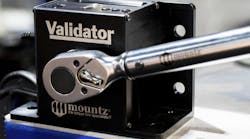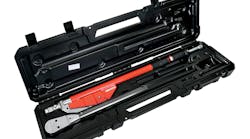Latest from Industry Trends
Your tools are your business. When they’re down, so are you. So, when a torque tool you depend on gets broken, it’s only natural to want to get it fixed as soon as possible. If you’re not in the business of making or repairing torque tools, this can take some time, and time, as you know, is money. As such, it’s best to set up testing and maintenance procedures to prevent or predict tools going out of service. When, despite your best efforts, a torque wrench does go down, there are a few simple steps to take to repair it as quickly as possible.
What to do When Your Torque Wrench is Broken
The simple answer is that you need to take your torque wrench out of service until you can repair or replace it. Using a broken or damaged tool can harm your operator, your product, or your other equipment. After all, if you’re using torque tools, you’re using them for a reason. The safety and reliability of your products depends on the torque applied to their fasteners.
To fix the problem, send the defective tool to a certified service center for repair. The standards the service center must meet can be found in the regulations applicable to your product or industry. For example, if you work in the automotive industry, your torque tools must be repaired under the standards referenced in the U.S. Department of Transportation code of regulations.
Advantages and Disadvantages of Sending Tools in for Repair
The advantage of sending your tools in for repair is guaranteed quality of service. When you send it to a professional center, you can be certain your tools will return in optimal condition. The drawback is time. It can take weeks to ship a tool, then wait for the repair and return shipping. It can also clog up your internal processes with increased paperwork and administration.
If you use a large number of torque tools, you will be exposed to the need for repair on a semi-regular or regular basis. To expedite the process and reduce administrative tasks, some service centers offer blanket purchase orders for specific times and amounts. They can fast-track service in some cases and deal with the administrative work in aggregate, instead of piecemeal. Another way to reduce downtime is to purchase backup tools, which you can then use when other tools are removed from the production line for repairs.
Repairing Torque Tools On Your Own
Your other option is to create your own certified service center. This will take a significant outlay of capital to invest in the equipment, personnel, footprint, and certification process. However, for companies that rely on a national or international scale, the investment could pay for itself by reducing service costs and downtime. To decide if you should invest in your own repair center, perform a cost-benefit analysis taking into account:
- The initial cost of the service center
- Fixed costs of the service center, including financing costs
- The volume of expected repairs, based on historical data
- Cost of downtime
- Current and expected downtime levels
- The current cost of service per tool, month, year, and decade
- The expected cost of service with an in-house service center
If, based on the volume of expected repairs, the anticipated costs of downtime and service with an in-house service center are lower than the current costs of downtime and service within a reasonable timeframe, then the investment may bear further consideration.
How to Prevent or Predict Torque Tools Going Out of Service
Quality torque tools are built to last. If your tools are properly maintained, unplanned downtime can be minimized. Advice for maintaining your torque tools will come in their instruction manuals, as will instructions for their proper usage.
The information found in a torque tool’s instruction manual will include calibration intervals, adjustment procedures, parts catalogs, and preventative maintenance procedures and schedules. These guidelines should be kept in a visible and accessible location and disseminated among your tool operators and repair technicians.
Tool damage doesn’t always follow a schedule. In addition to routine inspections, your operators should keep a close eye on the tools themselves to detect and report any malfunction or damage. Tools that provide inaccurate amounts of torque, dysfunctional mechanisms, or obvious physical damage such as cracks, chips, gouges, or deformity should be pulled from an operation and flagged for service. In addition, tools will naturally fall out of calibration over time, so it’s critical to maintain a regular calibration schedule.
Even letting a line go dark for some time can be better than working with a broken or damaged tool. Of course, it’s always a smart idea to have replacement tools handy, just in case something happens.
With the right preventative maintenance schedule and a careful eye, broken and damaged torque tools become uncommon. When accidents do happen, it’s good to have replacement tools ready to minimize downtime. Sending your tools to a service center will guarantee quality repairs. If you have many tools to repair, service agreements of in-house repair facilities will help streamline the process. Either way, be sure you have an established plan for when a valuable torque wrench goes out of service.














